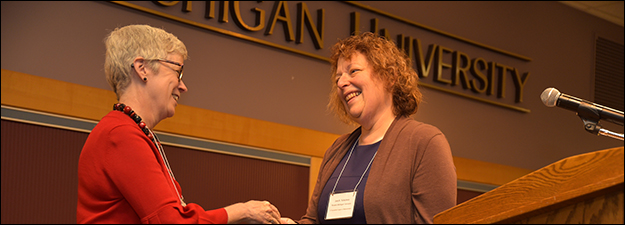New Approaches to the Helfta Nuns and Their Contemporaries
Sponsoring Organization(s)
Vernacular Devotional Cultures Group
Organizer Name
Catherine Annette Grisé
Organizer Affiliation
McMaster Univ.
Presider Name
Barbara Zimbalist
Presider Affiliation
Univ. of Texas-El Paso
Paper Title 1
God in the Book: Rethinking Corporeality in the Helfta Mystics
Presenter 1 Name
Jessica Barr
Presenter 1 Affiliation
Univ. of Massachusetts-Amherst
Paper Title 2
Anselmian Atonement Theory and Bridal Mysticism: The Purgatorial Piety of the Nuns of Helfta
Presenter 2 Name
Anna Harrison
Presenter 2 Affiliation
Loyola Marymount Univ.
Paper Title 3
"Ir Heimlich Freunde": Friendship among Women in Medieval German Convents
Presenter 3 Name
Robin K. Pokorski
Presenter 3 Affiliation
Northwestern Univ.
Paper Title 4
Respondent
Presenter 4 Name
Barbara Newman
Presenter 4 Affiliation
Northwestern Univ.
Start Date
14-5-2017 8:30 AM
Session Location
Valley III Stinson 306
Description
In the second half of the thirteenth century, the female monastery of Helfta played a significant role in the cultivation of Western European mysticism. The circle of nuns comprising three visionaries and their abbess—Mechtild of Hackeborn (1240-1298), Gertrud the Great of Helfta (1256-1302), Mechtild of Magdeburg (1207-1282/94, a beguine who joined Helfta later in life), and Gertrud of Hackeborn (1232-1292, Abbess of Helfta and sister of Mechtild), respectively—were responsible for several important visionary treatises (including Liber Specialis Gratiae, The Book of Special Grace, and Das fließende Licht der Gottheit, The Flowing Light of Divinity) that defined German mysticism for their time: for example, they developed nuptial mysticism using imagery of holy women as Brides of Christ, and dedicated themselves to the Devotion of the Sacred Heart as part of their active program of female education, piety, and community. This interdisciplinary session will allow scholars and students to showcase recent research on the Helfta nuns and explore how these holy women expanded and changed traditional paradigms, as well as to compare this material with that of other late-medieval mystics.
Barbara Zimbalist
New Approaches to the Helfta Nuns and Their Contemporaries
Valley III Stinson 306
In the second half of the thirteenth century, the female monastery of Helfta played a significant role in the cultivation of Western European mysticism. The circle of nuns comprising three visionaries and their abbess—Mechtild of Hackeborn (1240-1298), Gertrud the Great of Helfta (1256-1302), Mechtild of Magdeburg (1207-1282/94, a beguine who joined Helfta later in life), and Gertrud of Hackeborn (1232-1292, Abbess of Helfta and sister of Mechtild), respectively—were responsible for several important visionary treatises (including Liber Specialis Gratiae, The Book of Special Grace, and Das fließende Licht der Gottheit, The Flowing Light of Divinity) that defined German mysticism for their time: for example, they developed nuptial mysticism using imagery of holy women as Brides of Christ, and dedicated themselves to the Devotion of the Sacred Heart as part of their active program of female education, piety, and community. This interdisciplinary session will allow scholars and students to showcase recent research on the Helfta nuns and explore how these holy women expanded and changed traditional paradigms, as well as to compare this material with that of other late-medieval mystics.
Barbara Zimbalist


